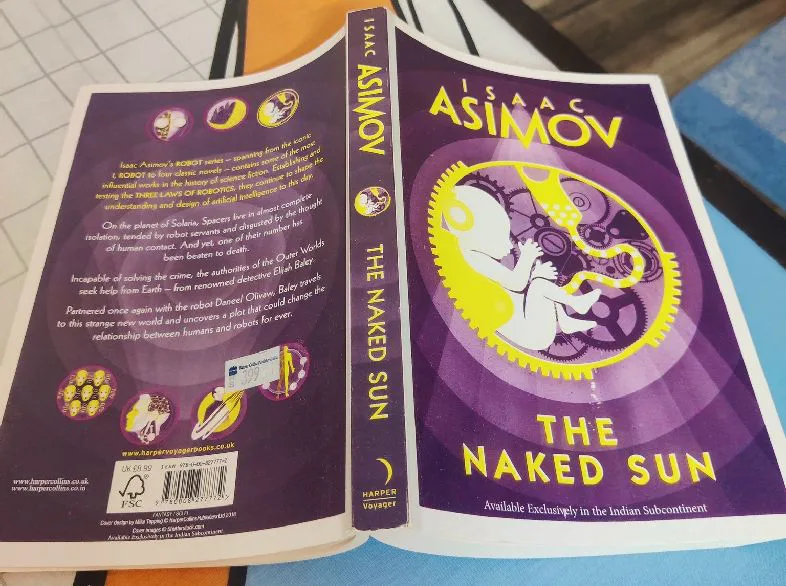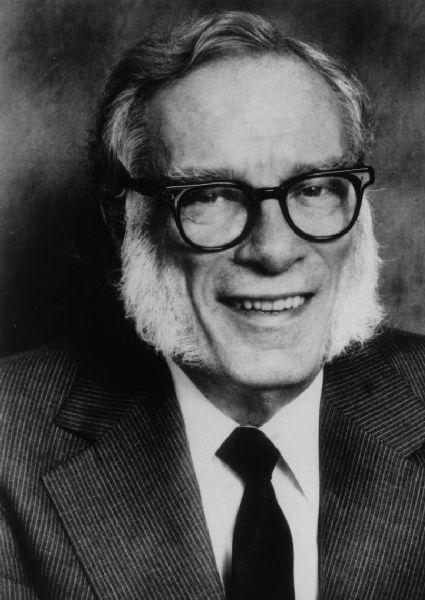
The Naked Sun is a captivating and enjoyable murder mystery that remains highly readable, even after several decades. It was published in 1957. And it is the second instalment in Asimov’s ‘Robot’ series, succeeding The Caves of Steel, which was released three years prior.
Asimov here presents a plethora of thought-provoking concepts, by exploring the boundaries of science, space, technology, psychology, and societal dynamics.
The book is set at a time in future, when civilization is divided into two groups:
- Spacers: they believed their future was in space. With the help of advanced robot technology, they leave Earth and settle on fifty different planets across the galaxy.
- Humans: those who preferred underground cities on Earth over Outer Worlds.
In one such galaxy, a planet called Solaria stands out as the foremost producer of robots. And this makes it a potential economic powerhouse in inhabited space.
When the story begins, we find, that the planet has asked help from Earth to solve a murder mystery.
Inhabitants on Solaria live in almost complete isolation. Communication, if necessary, is done via 3D holograms. They controlled births to control the population, using artificial insemination, and robots help with raising children. Any kind of personal contact, especially romantic or sexual, is considered disgusting.
A prominent scientist is murdered on Solaria. Since, they fall short of evidence, so they decide to take help from Earth.
Solarians are completely dependent on robots and so one option that surfaces is that the scientist could be killed by his own robots. This seems impossible because of the three laws of robotics that governed human-robot interactions. Therefore, to understand the human relationships and could figure out what might drive someone, or even a robot, to commit violence, they ask for help from Earth.
Eventually, detective Elijah Baley successfully investigates the murder, on a strange new world which has a totally different culture.
Dynamics between robot and humans
Asimov has explored the dynamics between robots and humans. Bots on Solaria are highly advanced. To prioritize human safety and well-being, they are programmed to follow the Three Laws of Robotics, strictly.
Robots assist humans in their daily lives, from household chores to communication and transportation. Solarians have strong aversion to personal contact therefore, they rely heavily on robotic assistance.
This presents a stark difference with Earth. Humans prefer more direct and frequent interaction for daily communications.
It is at this juncture, Detective Elijah Baley, an Earth detective, is sent to Solaria to investigate a murder. His understanding of “human psychology” and “interpersonal relationships” is seen as crucial in a society that struggles with such matters due to their isolation and reliance on robots.
Ethical implications of advanced robotics and AI
Ethical implications of advanced robotics and artificial intelligence has also been touched upon by the author.
Although, his Three Laws of Robotics are meant to govern the behavior of robots. However, it also raises questions about the nature of morality and the responsibilities that come with creating intelligent machines.
The Naked Sun is an example of potential conflicts and challenges that arise when applying these laws in complex situations. I could see similar notion prevailing in I, Robot, by the same author.
Asimov warns us that robots unintended consequences could lead to havoc for humanity.
Fear based on ignorance
The book also surfaces the nature of prejudice and fear based on ignorance.
Most of the time, we are biased towards other cultures. And this is reflected in terms of deep-seated biases between the Spacer and Earth societies.
We might be in a better position to develop empathy across boundaries, once we challenge these prejudices.

Takeaway
Asimov himself had developed The Three Laws of Robotics, with an idea to create an ethical system for humans and machines. And so, all his books revolve around the iteration and commutation of these laws. Therefore, I feel his works are full of his interesting thought experiments.
Through these thought experiments, he encourages readers to reflect on the potential consequences, moral dilemmas, and possibilities that arise from his meticulously crafted worlds.
Overall, The Naked Sun is a quick read with an interesting plot line, meticulous world-building, and thought-provoking concepts. And the author has convincingly explored the philosophical notions such as isolation, human connection, human behaviour, ethics in robotics, and the detrimental effects of prejudice and ignorance.
So, if you want to delve into the implications of a highly advanced robotic society, The Naked Sun will be an awesome choice. After reading this book, am so much looking forward to read Asimov’s the rise and fall of galactic empires a.k.a The Foundation series.



